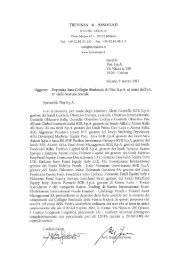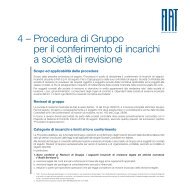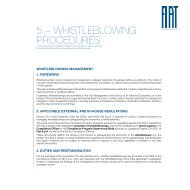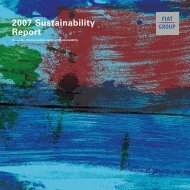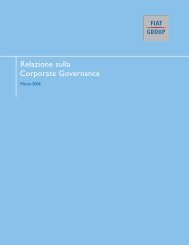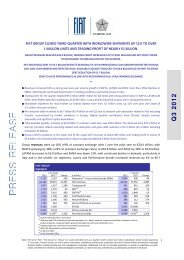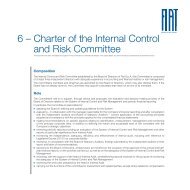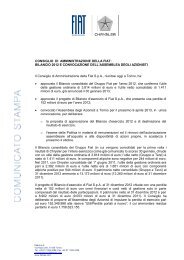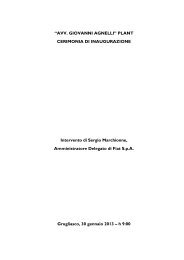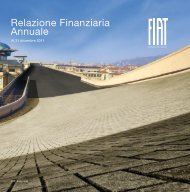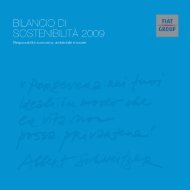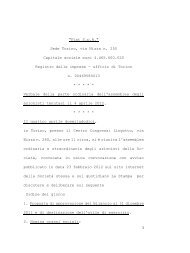annual report - FIAT SpA
annual report - FIAT SpA
annual report - FIAT SpA
You also want an ePaper? Increase the reach of your titles
YUMPU automatically turns print PDFs into web optimized ePapers that Google loves.
financial statement items, excluding those that only regard changes in terminology or editorial changes having a<br />
limited accounting effect and those that affect standards or interpretations that are not applicable to the Fiat Group.<br />
� IFRS 3 (2008) – Business Combinations: this amendment clarifies that the components of non-controlling<br />
interests that do not entitle their holders to a proportionate share of the entity’s net assets must be measured at<br />
fair value or as required by the applicable accounting standards. For example, therefore, stock options granted<br />
to employees must be measured in accordance with the requirements of IFRS 2 in the case of a business<br />
combination, while the equity portion of a convertible debt instrument must be measured in accordance with<br />
IAS 32. In addition, the Board goes into further detail on the question of share-based payment plans that are<br />
replaced as part of a business combination by adding specific guidance to clarify the accounting treatment.<br />
� IFRS 7 – Financial Instruments: Disclosures: this amendment emphasises the interaction between the<br />
qualitative and quantitative disclosures required by the standard concerning the nature and extent of risks<br />
arising from financial instruments. This should assist users of financial statements to link related disclosures<br />
and hence form an overall picture of the nature and extent of risks arising from financial statements. In addition,<br />
the disclosure requirement concerning financial assets that are past due or impaired but whose terms have<br />
been renegotiated, and that relating to the fair value of collateral have been eliminated.<br />
� IAS 1 – Presentation of Financial Statements: the amendment requires the reconciliation in the changes of<br />
each component of equity to be presented in the notes or in the primary statements.<br />
� IAS 34 – Interim Financial Reporting: by using a series of examples certain clarifications are provided<br />
concerning the additional disclosures that must be presented in interim financial <strong>report</strong>s.<br />
Application of this improvements is not expected to have any significant effects on the Group’s financial statements.<br />
On 7 October 2010, the IASB issued amendments to IFRS 7 – Financial Instruments: Disclosures. Entities are<br />
required to apply the amendments for <strong>annual</strong> periods beginning on or after 1 July 2011.The amendments will allow<br />
users of financial statements to improve their understanding of transfers of financial assets, including an<br />
understanding of the possible effects of any risks that may remain with the entity that transferred the assets. The<br />
amendments also require additional disclosures if a disproportionate amount of a transfer transaction is undertaken at<br />
the end of a <strong>report</strong>ing period. The amendments had not yet been endorsed by the European Union at the date of<br />
these financial statements.<br />
On 20 December 2010, the IASB issued amendments to IFRS 1 – First-time Adoption of International Financial<br />
Reporting Standards. The first amendment replaces references to a fixed date of “1 January 2004” with the date of<br />
transition to IFRSs. The second amendment provides guidance on how an entity should resume presenting financial<br />
statements in accordance with IFRSs after a period when the entity was unable to comply with IFRSs because its<br />
functional currency was subject to severe hyperinflation. These amendments are effective from 1 July 2011. The<br />
amendments had not yet been endorsed by the European Union at the date of these financial statements.<br />
On 20 December 2010, the IASB issued amendments to IAS 12 – Income Taxes that require an entity to measure the<br />
deferred tax relating to an asset depending on whether the entity expects to recover the carrying amount of the asset<br />
through use or sale. As a result of the amendments, SIC-21 Income Taxes – Recovery of Revalued Non-Depreciable<br />
Assets no longer applies. These amendments are effective from 1 January 2012. The amendments had not yet been<br />
endorsed by the European Union at the date of these financial statements.<br />
RISK MANAGEMENT<br />
Credit risk<br />
The Group’s credit concentration risk differs in relation to the activities carried out by the individual sectors and various<br />
sales markets in which the Group operates; in all cases, however, the risk is mitigated by the large number of<br />
counterparties and customers. Considered from a global point of view, however, there is a concentration of credit risk<br />
in trade receivables and receivables from financing activities, in particular dealer financing and finance leases in the<br />
European Union market for the Fiat Group Automobiles and Trucks and Commercial Vehicles sectors, in North<br />
America for the Agricultural and Construction Equipment sector, as well as in Latin America for all main sectors.<br />
Financial assets are recognised in the statement of financial position net of write-downs for the risk that counterparties<br />
may be unable to fulfil their contractual obligations, determined on the basis of the available information as to the<br />
creditworthiness of the customer and historical data.<br />
Fiat Group Consolidated Financial Statements at 31 December 2010 127



